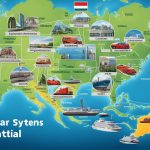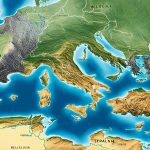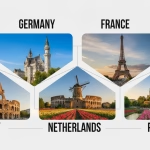Explore the pros and cons of living and working in some of the top countries in the world. Make an informed decision about where to start your next chapter.
In today’s world, where everything is connected, people naturally like to compare how well different countries are doing in different areas. This has made ranking countries based on how they’re moving towards becoming societies and economies built on knowledge much more critical.
In this interesting article, we will look closely at the comparisons between the top countries that are leading the world. This will help us understand how these countries differ based on GDP, education, population, unemployment levels, cost of living, etc. Our goal is to discover the differentiating factors that have made these countries the best in the world.
This article can assist you in assessing and comparing the cost of living in other countries, whether you are considering moving, making travel plans, or looking into investment opportunities.
UK vs. USA
Population:
The United States has a significantly larger population than the United Kingdom. The USA boasts a population of approximately 334 million, while the UK has around 67 million residents.
GDP:
The economic prowess of the United States is evident in its Gross Domestic Product (GDP), which stands as the world’s largest. The USA’s GDP is around $20.40 trillion, surpassing the UK’s approximately $3.31 trillion GDP.
Annual GDP Growth:
In terms of annual GDP growth, the USA has generally exhibited a slightly lower growth rate than the UK in recent years. The US typically experiences a growth rate of around 2-3%, while the UK has seen growth rates ranging from 1-2%.
Economy:
The US economy is highly diversified, comprising various sectors such as technology, finance, manufacturing, and services. The UK’s economy is diverse, with strengths in finance, services, and creative industries.
Cost of Living:
The cost of living tends to be higher in the UK, especially in cities like London. Due to its vast size and regional variations, the USA showcases a range of living costs, with major cities like New York and San Francisco being costly.
Unemployment Rate:
Historically, the US has maintained a slightly lower unemployment rate than the UK. The US rate hovers around 3.5-4%, whereas the UK’s rate is generally in the 4-5% range.
Education System:
Both countries have prestigious higher education institutions, with the USA having more globally recognized universities. The UK is known for its traditional universities like Oxford and Cambridge, while the US is home to Ivy League schools and major research universities.
Finance and Trade:
The USA’s financial markets, including Wall Street, are global financial hubs. The UK boasts the City of London, a significant financial center. Both countries engage in extensive international trade, with the US having a larger trade volume due to its more extensive economy.
Weather Conditions:
The UK is characterized by its temperate maritime climate, which leads to moderate temperatures and frequent rainfall. In contrast, the USA’s weather varies significantly due to its vast size, encompassing everything from arctic conditions in Alaska to tropical climates in Florida.
China vs. India
Population:
India boasts the world’s largest population, 1.430 billion citizens, while China closely follows with approximately with over 1.425 billion people,
GDP:
China leads in Gross Domestic Product (GDP), recording around $17.96 trillion, whereas India’s GDP is approximately $3.7 trillion.
Annual GDP Growth:
China has maintained a consistent annual GDP growth rate of around 6-8% in recent years. India’s growth rate, though impressive, is slightly lower, ranging from 4-7%.
Economy:
China is known for its diverse and robust manufacturing sector, contributing significantly to its GDP. Conversely, India has a service-oriented economy, with sectors like Information Technology, telecommunications, and financial services playing pivotal roles.
Cost of Living:
The cost of living in China’s major cities tends to be higher than most cities in India. Urban areas in India generally offer a more affordable cost of living.
Unemployment Rate:
China’s unemployment rate hovers around 5%, whereas India’s unemployment rate can vary but is generally higher, ranging from 6-9%.
Education System:
Both countries emphasize education, with China’s highly structured and centralized education system. India’s education system is diverse, with a mix of public and private institutions.
Finance and Trade:
China is a global economic powerhouse, ranking as the world’s largest exporter and second-largest importer. India is also a significant player in global trade, focusing on services and textiles.
Weather Conditions:
China experiences diverse climates due to its vast size, ranging from arid deserts to icy plateaus. India features a variety of climates, including tropical, arid, and temperate regions.
France vs. Germany
Population:
France and Germany are two prominent European nations with substantial populations. France’s population stands at approximately 67.75 million, while Germany boasts a population of around 83.2 million. Despite being geographically close, their demographic sizes differ significantly.
GDP:
Regarding Gross Domestic Product (GDP), France and Germany are economic powerhouses within the European Union. France’s GDP is estimated at $3.124 trillion, whereas Germany’s GDP is notably higher, reaching $4.504 trillion. This places Germany as one of the leading economies not only in Europe but globally as well.
Annual GDP Growth:
When it comes to economic growth, Germany has consistently displayed robust performance. Germany experienced an annual GDP growth rate of 1.8% in the past year, while France’s economy expanded by 2.56%. Germany’s comparatively more substantial GDP growth reflects its resilient economic policies and industrial prowess.
Economy:
Both countries have diverse economies with strengths in manufacturing, technology, and services sectors. Germany is renowned for its automotive and machinery industries, while France excels in luxury goods, aerospace, and tourism. Their combined economic influence shapes the dynamics of the European market.
Cost of Living:
The cost of living in both countries varies. On average, France has a slightly higher cost of living index than Germany. This can impact housing, consumer goods, and overall affordability.
Unemployment Rate:
Germany maintains a lower unemployment rate compared to France. The latest data indicates that Germany’s unemployment rate is around 5.7%, while France’s is 7.46%. Germany’s efficient labor market policies contribute to its lower unemployment figures.
Education System:
Both France and Germany have well-developed education systems that emphasize academic excellence. France is known for its prestigious universities and a strong focus on research, while Germany’s dual education system integrates practical training with theoretical learning.
Finance and Trade:
Germany is recognized for its robust trade surplus and export-oriented economy. Its strategic location and manufacturing capabilities have contributed to its strong trade relationships globally. France also boasts a formidable trade sector, with diverse exports ranging from aerospace to agri-food products.
Weather Conditions:
France and Germany exhibit varied climate patterns due to their geographical diversity. France enjoys a mix of Mediterranean and temperate climates, offering diverse weather experiences across the country. Germany experiences a continental climate with distinct seasons, including cold winters and warm summers.
Japan vs. South Korea
Population:
Japan boasts a population of approximately 126 million people, making it one of the most densely populated countries in the world. Meanwhile, South Korea has a population of around 51 million, positioning it as one of Asia’s more densely populated countries.
GDP:
Japan holds a substantial economic position with a GDP of around $5 trillion, ranking it among the world’s top economies. While not as large as Japan, South Korea still wields a formidable economic power with a GDP of about $1.6 trillion.
Annual GDP Growth:
Japan maintains a relatively modest growth rate of around 1% in terms of annual GDP growth. On the other hand, South Korea has shown a slightly higher growth rate, hovering around 2-3%, indicating a more rapidly expanding economy.
Economy:
Japan’s economy is known for its diverse industrial sectors, including automotive, electronics, and robotics. South Korea, similarly, boasts a solid industrial base, with significant contributions from industries like technology, shipbuilding, and steel.
Cost of Living:
The cost of living in Japan is notably higher compared to South Korea. Tokyo, in particular, consistently ranks among the world’s most expensive cities. In contrast, South Korea offers a more affordable cost of living, appealing to budget-conscious residents and tourists.
Unemployment Rate:
Both countries maintain relatively low unemployment rates. Japan’s unemployment rate hovers around 3-4%, while South Korea’s unemployment rate is slightly higher, ranging from 3-5%.
Education System:
Both Japan and South Korea have highly regarded education systems. Japan strongly emphasizes academic excellence, with a rigorous curriculum and a focus on innovation. South Korea is also renowned for its educational standards, particularly in mathematics and science.
Finance and Trade:
Japan’s financial sector is well-established, with central global banks and a significant presence in international trade. South Korea has also made a mark in global trade, particularly in the electronics and automotive industries, contributing significantly to its economy.
Weather Conditions:
Japan experiences diverse weather conditions due to its geographical location, including four distinct seasons. South Korea, located nearby, shares similar weather patterns, with a temperate climate and distinct seasonal changes.
USA vs. Canada
Population:
The United States and Canada are both sizable nations, with the USA having a significantly larger population. As of the latest data, the USA boasts a population of approximately 334 million, while Canada’s population is around 38 million.
GDP:
The economic prowess of these nations is noteworthy. The USA holds the title of the world’s largest economy, with a GDP of around $20.40 trillion, dwarfing Canada’s GDP of approximately $2.17 trillion.
Annual GDP Growth:
The USA generally experiences a growth rate of about 2-3% in terms of annual GDP growth, while Canada’s growth rate tends to be slightly lower at around 1-2%.
Economy:
The USA’s diverse economy spans various industries, including technology, finance, entertainment, and manufacturing. Canada, while diversified, relies significantly on natural resources, particularly its vast oil reserves.
Cost of Living:
Both countries exhibit varying costs of living. Generally, major US cities like New York and Los Angeles have higher living costs than most Canadian cities like Toronto and Vancouver. However, it’s important to note that the cost of living can vary widely within each country.
Unemployment Rate:
Historically, the unemployment rate in the USA has been slightly lower than in Canada. The USA’s rate hovers around 3.5-4%, while Canada’s tends to be around 5.50-7%.
Education System:
Canada is often lauded for its robust education system, with a high emphasis on quality and inclusivity. The USA boasts prestigious universities and research institutions, but access to education can sometimes be influenced by factors such as tuition fees.
Finance and Trade:
The USA has a highly developed financial sector that engages in extensive international trade. Canada, while having strong trade ties, particularly with the US, is less influential on the global financial stage.
Weather Conditions:
Due to its vast size, the weather in the USA and Canada can vary significantly by region. Both countries experience a range of climates, from the tropical climate of Florida to the Arctic conditions in northern Canada.




































